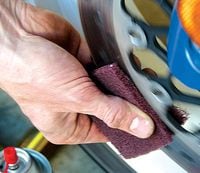New brake pads need to be broken in properly if they’re going to deliver all the performance you paid for. It’s not enough to jam them into the caliper, button everything up, and head out for a long ride expecting your bike to have brick-wall stopping power. If you think that you’re probably already acquainted with pins and plaster.
Installing new pads should be done with care and consideration. Cleanliness is critical. Spray or wipe down the entire system with commercially available brake cleaner, and be sure you keep any other chemicals—including brake fluid—off the pads and discs. Take your time and inspect every part of the braking system: caliper bodies, discs, mounting hardware, and each of the lines from the master cylinder all the way to the caliper. You’re looking for cracks, leaks, and evidence of damage, either from physical contact or heat.
Savvy owners will take the time to de-glaze the rotors before installing new pads. Simply use a red Scotch-Brite pad and your brake [cleaner to scrub down the surface of the disc, followed by a wipe down with a clean rag. You’re doing this to eliminate surface contamination but also to roughen the disc surface so that the pads will bed in more quickly.
When you first install new, smooth pads, they contact the rotor only on high spots. Hard stopping puts all the pressure of braking on this small area, creating hot spots that can cause pad material to transfer to the rotor. Braking gently during the first few miles on new pads gives them and the rotor time for their surfaces to mate, increasing the contact area between them without creating hot spots. At that point, EBC, for one, recommends 10 hard stops from 60 to 20 mph to intentionally heat-cycle organic and semi-metallic pads; this process is the final curing of the pad. (Hard stops do not mean locking the wheel; you need the wheel turning to create the friction that in turn makes the heat.) Sintered-metallic pads are tougher but take considerably longer to break in. Watch the discs closely for the first few hundred miles to determine the pads are making even contact across the face of the disc.
For more information on EBC brake products, visit their website HERE.
PHOTO: Brian MacLean












/cloudfront-us-east-1.images.arcpublishing.com/octane/S35YGSEMEZB4BLTDJTSZPF4GLA.jpg)
/cloudfront-us-east-1.images.arcpublishing.com/octane/5UOT6HPX2JFMRJAX6EH45AR4MQ.jpg)
/cloudfront-us-east-1.images.arcpublishing.com/octane/OKWOJWAKP5EP3OACCRRWPCIX2Q.jpg)
/cloudfront-us-east-1.images.arcpublishing.com/octane/2WF3SCE3NFBQXLDNJM7KMXA45E.jpg)
/cloudfront-us-east-1.images.arcpublishing.com/octane/G4MG6OUCJNBSHIS2MVVOTPX65E.jpg)
/cloudfront-us-east-1.images.arcpublishing.com/octane/IIGGWFOTOJGB7DB6DGBXCCMTDY.jpg)
/cloudfront-us-east-1.images.arcpublishing.com/octane/QSTCM6AVEZA5JJBUXNIQ3DSOF4.jpg)
/cloudfront-us-east-1.images.arcpublishing.com/octane/U4I7G625B5DMLF2DVIJDFZVV6M.jpg)
/cloudfront-us-east-1.images.arcpublishing.com/octane/B6XD6LS6IVCQPIU6HXDJSM3FHY.jpg)
/cloudfront-us-east-1.images.arcpublishing.com/octane/ICL63FEDDRDTTMINYICCEYGMDA.jpg)
/cloudfront-us-east-1.images.arcpublishing.com/octane/FCGZHQXRBZFLBAPC5SDIQLVF4I.jpg)
/cloudfront-us-east-1.images.arcpublishing.com/octane/WNOB6LDOIFFHJKPSVIWDYUGOPM.jpg)

/cloudfront-us-east-1.images.arcpublishing.com/octane/X33NU3E525ECRHXLNUJN2FTRKI.jpg)
/cloudfront-us-east-1.images.arcpublishing.com/octane/6KKT5NNL2JAVBOXMZYS5ZO76YA.jpg)
/cloudfront-us-east-1.images.arcpublishing.com/octane/J5RKG5O455GMPGQRF2OG6LRT7A.jpg)
/cloudfront-us-east-1.images.arcpublishing.com/octane/GX2CIZKQVRH2TATDM26KFG2DAE.jpg)
/cloudfront-us-east-1.images.arcpublishing.com/octane/ZWIDYSAKQZHD5BHREMQILXJCGM.jpg)
/cloudfront-us-east-1.images.arcpublishing.com/octane/CYUHJZCTSJCH3MRAQEIKXK7SCQ.jpg)
/cloudfront-us-east-1.images.arcpublishing.com/octane/LKOFINY56FCXJCANJ5M7ZDQUBY.jpg)
/cloudfront-us-east-1.images.arcpublishing.com/octane/4NBPDACMWJH63JQYJVK3QRBDZI.jpg)
/cloudfront-us-east-1.images.arcpublishing.com/octane/KKHQHRR3FJGX7H2IPU6RALMWG4.jpg)

/cloudfront-us-east-1.images.arcpublishing.com/octane/5IOFS5JAE5FOXMNA23ZRAVVYUU.jpg)